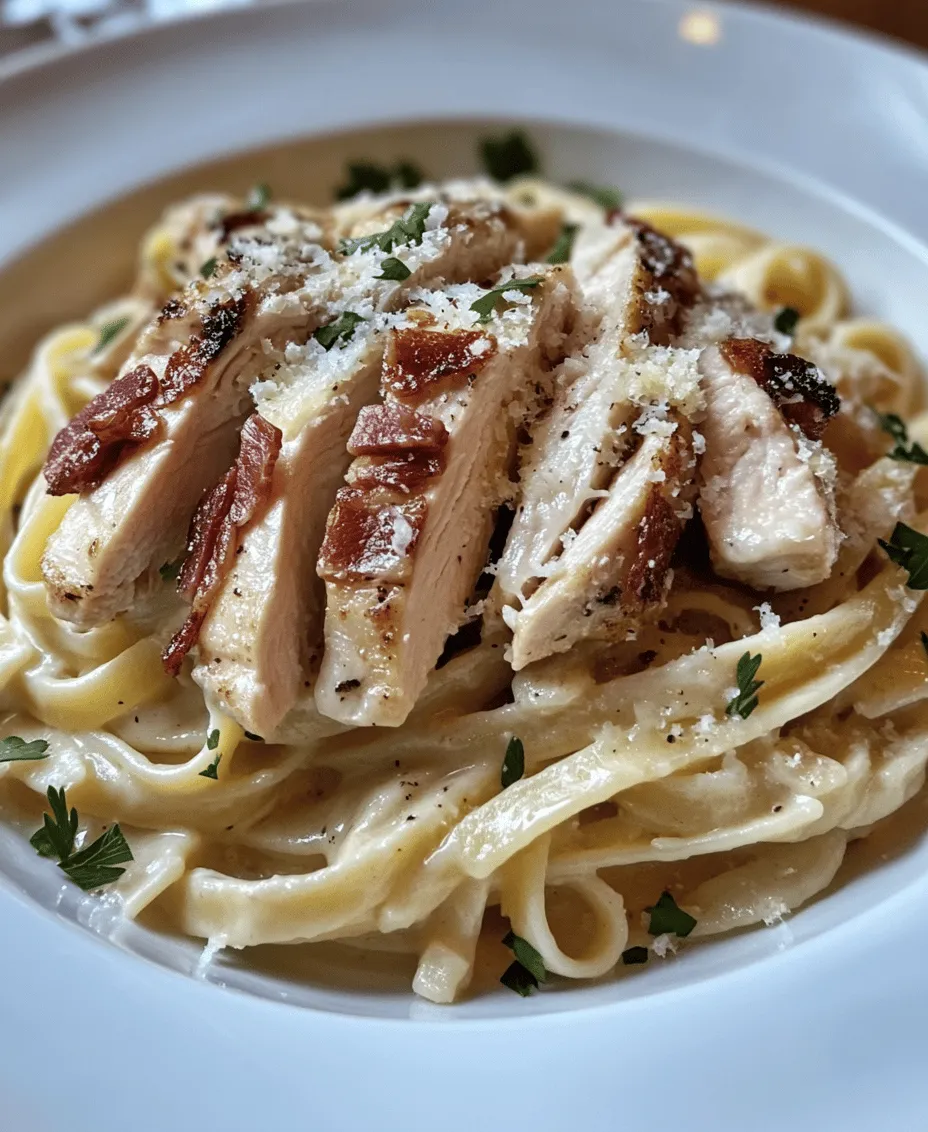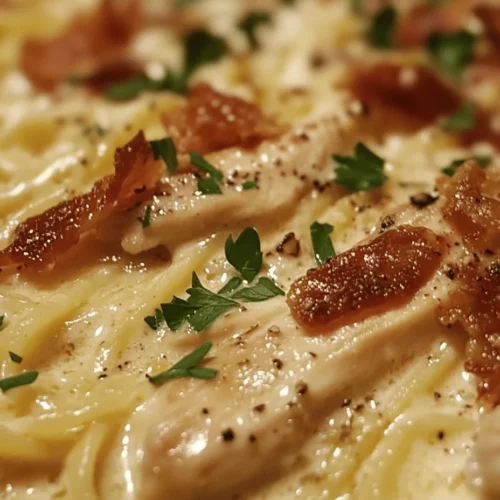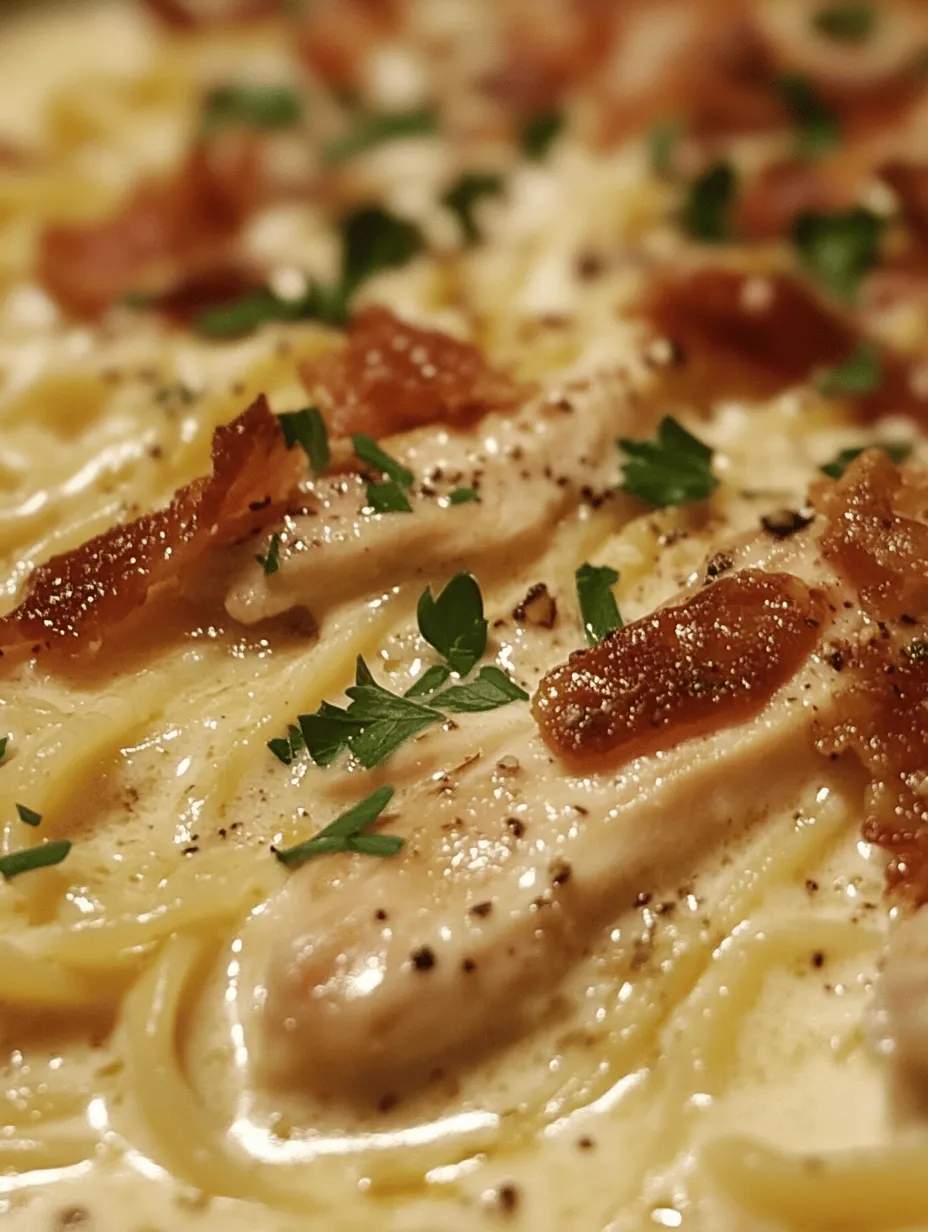In the realm of Italian cuisine, few dishes evoke the same level of comfort and satisfaction as Chicken Carbonara. This creamy pasta dish, traditionally made with a decadent blend of eggs, cheese, and pancetta, has been reimagined here to incorporate tender chicken for an even heartier meal. The combination of rich flavors and creamy textures makes this dish a perfect fit for family dinners or special occasions. Whether you are celebrating a holiday or simply looking for a comforting weeknight dinner, this Chicken Carbonara recipe promises to deliver a rich flavor experience that will leave everyone at your table asking for seconds.
As we delve into the preparation of this Best-Ever Chicken Carbonara, it’s essential to understand the origins of this beloved dish and the key ingredients that make it a standout. Carbonara has a rich history steeped in tradition, and knowing its background can enhance the appreciation of your culinary creation. In this article, we will explore not only the step-by-step instructions to create this delectable dish but also the intriguing stories behind its inception, variations, and tips for achieving the perfect creamy texture.
The Origins of Carbonara: A Culinary Journey
Historical Background of Carbonara
The origins of Carbonara are somewhat shrouded in mystery, with several theories surrounding how this iconic dish came to be. Most food historians agree that Carbonara likely emerged in the mid-20th century in Rome, but the exact details are debated. Some speculate that it was created by Italian charcoal workers, known as “carbonari,” who would cook simple meals over their campfires, using easy-to-transport ingredients like eggs, cured pork, and pasta. Others believe that it was influenced by American soldiers stationed in Italy during World War II, who introduced bacon and eggs to the local cuisine.
Theories on the Dish’s Inception
One popular theory suggests that Carbonara’s name derives from the Italian word “carbone,” which means “coal.” This connection implies that the dish was a hearty meal prepared by coal workers using readily available ingredients. Alternatively, some historians argue that the dish was initially served in a more rustic form, without the creamy sauce we know today, instead relying solely on the emulsification of eggs and cheese to create a rich coating for the pasta.
Regional Variations in Italy
As with many traditional dishes, Carbonara has regional variations across Italy. In its classic Roman form, the dish utilizes guanciale (cured pork cheek) and Pecorino Romano cheese. However, adaptations exist, with some incorporating different types of cured meats or cheeses based on local preferences and availability. In the realm of American cooking, the introduction of cream has become a common practice, leading to a richer, more indulgent version of the dish. The Chicken Carbonara recipe takes inspiration from these variations while maintaining the core essence of the original.
The Role of Ingredients in Traditional Carbonara
Discussion of Classic Ingredients like Guanciale and Pecorino Romano
In traditional Carbonara, the star ingredients are guanciale and Pecorino Romano. Guanciale offers a unique flavor profile, characterized by its rich, fatty texture and slightly sweet taste. It provides the necessary depth to the dish, while Pecorino Romano adds a sharp, tangy element that balances the creamy sauce beautifully. The use of these classic ingredients is what makes Carbonara a standout dish, but the Chicken Carbonara adaptation introduces additional elements that enhance the overall flavor and heartiness.
Comparison with the Chicken Version and Its Adaptations
In adapting the recipe to include chicken, we enhance the dish’s heartiness while still respecting its traditional roots. While guanciale can still be used, pancetta is a more accessible substitution for many home cooks. The addition of boneless, skinless chicken breasts not only makes the dish more filling but also brings a new layer of flavor to the table, creating a satisfying meal that caters to both pasta and protein lovers alike.
Understanding the Key Ingredients of Chicken Carbonara
To craft the Best-Ever Chicken Carbonara, understanding the specific ingredients and their roles is crucial. Each component contributes to the overall flavor and texture, making the final dish a harmonious blend of tastes.
Fettuccine Pasta: The Perfect Base
When it comes to pasta, fettuccine is the ideal choice for Chicken Carbonara. Its flat, wide shape allows it to hold onto the creamy sauce beautifully, ensuring each bite is rich and flavorful. The texture of fettuccine complements the dish, providing a satisfying chew that pairs well with the tender chicken and savory pancetta.
For those with dietary preferences or restrictions, alternatives such as whole wheat fettuccine or gluten-free pasta can be used without sacrificing the integrity of the dish.
The Chicken Component: Choosing the Right Cut
The chicken is a vital component of this adaptation. Boneless, skinless chicken breasts are often the go-to choice due to their ease of preparation and ability to absorb flavors. It’s essential to season the chicken generously before cooking to enhance its taste. For a more robust flavor, consider using bone-in chicken thighs, which can provide additional moisture and richness.
When cooking chicken for Carbonara, aim for a golden-brown sear to develop flavor, and ensure the chicken is cooked through without becoming dry.
Pancetta vs. Guanciale: Making the Right Choice
When it comes to the cured pork in Chicken Carbonara, both pancetta and guanciale can be used effectively. Pancetta is more widely available and has a milder flavor compared to guanciale, making it a suitable substitute. It offers a slightly salty and savory profile that complements the dish well.
If you can find guanciale, it will elevate the dish with its unique flavor, but in its absence, pancetta will work just fine. For a different twist, if neither is available, you can opt for thick-cut bacon, which will add a smoky flavor to the dish.
The Creamy Sauce: Balancing Flavor and Texture
The creamy sauce is what truly sets Chicken Carbonara apart from other pasta dishes. The combination of eggs, heavy cream, and freshly grated Parmesan cheese creates a luscious coating that envelops the pasta. The eggs serve as a thickening agent, while the cream adds richness and smoothness.
To achieve the perfect creamy consistency, it’s crucial to temper the eggs before adding them to the pasta. This process involves slowly mixing the hot pasta with the egg mixture to prevent scrambling. The result is a velvety sauce that clings to the fettuccine and enhances every bite.
Step-by-Step Guide to Making the Best-Ever Chicken Carbonara
Preparation: Gathering Your Ingredients
Before diving into the cooking process, it’s essential to gather all your ingredients and tools. This practice, known as mise en place, will streamline your cooking experience and ensure you have everything at your fingertips.
Ingredients Needed:
– 12 ounces of fettuccine pasta
– 2 boneless, skinless chicken breasts
– 4 ounces of pancetta or guanciale, diced
– 3 large eggs
– 1 cup of heavy cream
– 1 cup of freshly grated Parmesan cheese
– Salt and pepper, to taste
– Fresh parsley, chopped (for garnish)
Suggested Kitchen Tools:
– A large pot for boiling pasta
– A skillet for cooking chicken and pancetta
– A mixing bowl for the sauce
– A whisk for combining the eggs and cream
– A colander for draining pasta
Cooking the Pasta to Perfection
Cooking the pasta is a vital step in achieving the best texture for your Chicken Carbonara. Start by bringing a large pot of salted water to a rolling boil. The salt is essential as it enhances the flavor of the pasta. Once the water is boiling, add the fettuccine and cook according to package instructions until al dente, usually about 8-10 minutes.
Be sure to reserve about a cup of the pasta cooking water before draining, as this starchy water can be added later to adjust the sauce’s consistency if needed.
With your ingredients prepared and your pasta cooked to perfection, you are well on your way to creating the Best-Ever Chicken Carbonara. Stay tuned as we move forward into the cooking process, where the magic happens, and each component comes together to create a dish that embodies comfort and satisfaction.

Importance of Reserving Pasta Water
One of the most crucial yet often overlooked steps in preparing a delectable Chicken Carbonara is reserving pasta water. This starchy water is the secret weapon that can elevate the creaminess of your sauce without overwhelming it. When you cook pasta, it releases starch into the water, creating a silky texture that binds with your sauce. By adding this reserved water gradually to your dish, you can adjust the consistency of the sauce to your liking, ensuring it clings perfectly to the pasta for a luscious mouthfeel. Aim to reserve about a cup of this golden liquid before draining your spaghetti to ensure you have enough to achieve that desired creamy sauce.
Searing the Chicken: Techniques for Juiciness
How to Properly Season and Cook Chicken Breasts
To create juicy and flavorful chicken for your Carbonara, start by seasoning your chicken breasts generously with salt and freshly cracked black pepper. You can also consider marinating the chicken in olive oil, garlic, and Italian herbs for at least 30 minutes prior to cooking, which can infuse the meat with additional flavor. When it comes to cooking, heat a large skillet over medium-high heat and add a tablespoon of olive oil. Once the oil is shimmering, carefully place the chicken breasts in the pan. Avoid overcrowding to ensure even cooking.
Cook the chicken for about 6-7 minutes on one side without moving it, allowing a golden-brown crust to form. Flip the breasts and continue cooking for another 5-6 minutes or until the internal temperature reaches 165°F (75°C). This method not only helps to sear the chicken, locking in juices, but also gives a delightful flavor profile that complements the creamy sauce.
Methods to Retain Moisture in the Chicken
To keep your chicken breasts moist, consider the following tips:
1. Avoid Overcooking: Use a meat thermometer to check for doneness. Overcooked chicken can become dry and rubbery.
2. Let It Rest: After removing the chicken from the skillet, let it rest for about 5 minutes before slicing. This resting period allows the juices to redistribute throughout the meat, ensuring each bite is tender and juicy.
3. Use Bone-In Chicken: If you prefer, opt for bone-in, skin-on chicken breasts. The bone helps retain moisture during cooking, resulting in more flavorful meat.
Creating the Perfect Pancetta Crisp
Timing and Temperature for Optimal Crispness
Pancetta, a type of Italian cured pork, adds a delightful savory flavor to your Chicken Carbonara. To achieve the perfect crisp, start by slicing the pancetta into small cubes. Heat a skillet over medium heat and add the pancetta. Cook it slowly, allowing the fat to render out, which will result in crispy pieces of pancetta without burning. This process typically takes about 5-8 minutes. Stir occasionally, ensuring even cooking while keeping an eye on the temperature; too high can lead to burnt bits rather than a perfect crisp.
Combining Flavors with Garlic
For an aromatic depth, add minced garlic to the pancetta during the last minute of cooking. This timing allows the garlic to infuse the fat without burning, creating a fragrant base for your sauce. Once the pancetta is crisped to perfection, remove it from the pan and set it aside, leaving the rendered fat to flavor the sauce.
Crafting the Creamy Sauce
How to Mix Egg and Cheese Without Scrambling
The creamy sauce in Chicken Carbonara primarily comes from a mixture of eggs and cheese, typically Parmigiano-Reggiano or Pecorino Romano. To prevent scrambling, it’s essential to temper the eggs. In a mixing bowl, whisk together your eggs and grated cheese until well combined. Once your pasta is cooked and drained (remember to reserve that pasta water), quickly add the hot pasta directly to the egg and cheese mixture while stirring vigorously. The heat from the pasta will gently cook the eggs, creating a creamy sauce without curdling.
Adjusting the Sauce’s Thickness with Pasta Water
If your sauce appears too thick, gradually add reserved pasta water, one tablespoon at a time, while continuing to stir. This will help achieve the desired creaminess and ensure the sauce adheres beautifully to the pasta. The key is to add just enough water to reach your ideal consistency, without making the sauce runny.
Bringing It All Together
Techniques for Combining the Ingredients Seamlessly
Now it’s time to bring all the components of your Chicken Carbonara together! In the skillet that once held your pancetta, combine the cooked pasta, crispy pancetta, and the creamy egg mixture. Toss everything gently over low heat to ensure the sauce envelops every strand of pasta evenly. The residual heat from the pasta will help to thicken the sauce further and meld all the flavors beautifully.
Tips for Serving and Garnish Presentation
When serving your Chicken Carbonara, consider the presentation. Use tongs to twirl the pasta into a nest-like shape on each plate for a refined look. Top each serving with an additional sprinkle of cheese and freshly cracked black pepper. A light sprinkle of chopped fresh parsley adds a vibrant pop of color and a hint of freshness, balancing the richness of the dish.
Serving Suggestions for Your Chicken Carbonara
Ideal Pairings: Side Dishes and Wine
To create a well-rounded meal, consider pairing your Chicken Carbonara with a fresh, crisp salad, such as a simple arugula salad dressed with lemon vinaigrette. The acidity from the dressing will cut through the richness of the pasta, providing a delightful contrast. A side of garlic bread or a crusty Italian loaf is also a perfect accompaniment for sopping up any leftover sauce.
When it comes to wine, a white wine like Pinot Grigio or a light-bodied red, such as Chianti, complements the creamy pasta beautifully. The acidity in these wines will enhance the flavors and provide a refreshing balance.
Garnishing Your Dish
Garnishing your Chicken Carbonara can elevate the dish’s presentation and flavor. While fresh parsley is a classic choice, consider adding additional toppings, such as a sprinkle of red pepper flakes for a hint of spice or toasted pine nuts for extra crunch. A drizzle of high-quality extra virgin olive oil can also enhance the dish’s richness.
Nutritional Insights: Understanding the Benefits of Chicken Carbonara
Analyzing the Nutritional Profile
Chicken Carbonara is not only delicious but can also be a balanced meal when prepared thoughtfully. A typical serving contains around 600-700 calories, depending on portion size and specific ingredients used. The dish is rich in protein from the chicken and eggs, with healthy fats coming from the pancetta and cheese. It also offers carbohydrates from the pasta, providing energy.
Health Benefits of Key Ingredients
Chicken is a lean protein source, essential for muscle growth and repair. Eggs are nutrient-dense, providing essential vitamins like B12 and D, along with healthy fats. The addition of garlic not only enhances flavor but also boasts numerous health benefits, including potential immune-boosting properties. When using whole grain pasta, you can increase fiber intake, contributing to better digestion.
Modifications for Dietary Needs
For those with dietary restrictions, Chicken Carbonara can be easily modified. For a gluten-free option, substitute traditional pasta with gluten-free varieties made from rice, quinoa, or lentils. To lower the calorie count, consider using less cheese or swapping heavy cream with Greek yogurt for a tangy flavor.
For vegetarians, a meatless version can be created using sautéed mushrooms or smoked tofu in place of chicken and pancetta. These ingredients can provide a similar umami flavor profile while keeping the dish hearty and satisfying.
Conclusion: Enjoying Your Homemade Chicken Carbonara
Mastering the art of Chicken Carbonara not only allows you to delight in a beloved Italian classic but also equips you with the skills to customize the dish to your taste. With its rich flavors and creamy texture, this recipe is sure to become a staple in your cooking repertoire. Whether enjoyed on a cozy night in or shared with loved ones at a dinner party, the best-ever Chicken Carbonara is a dish that embodies warmth, comfort, and culinary satisfaction.
So gather your ingredients, roll up your sleeves, and embark on this delicious journey to create a Chicken Carbonara that’s not only satisfying but also a testament to your cooking prowess. Enjoy every creamy bite, and don’t forget to share your culinary masterpiece with friends and family!



